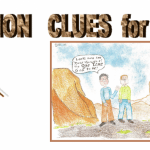Swim away little fishies! I thought as I slowly dunked a plastic jug into the murky water of the river, careful to keep my precariously balanced position on the rocks. Fascinated, I watched some of the fish up close as they swam just inches away from my hand, hoping none of them would try to swim inside my jug and sacrifice themselves to become part of our team’s project. As soon as the jug finished gulping all the water it could hold, I brought it back to where we were working on the dinosaur footprint fossils. As soon as everything else was in place and ready to go, I got to work mixing white plaster powder with the water.

During my brief time working on a dig in Glen Rose, Texas, this summer our team made a mold of one of the fossil dinosaur footprints in the Paluxy River bed. A mold can be used to make precisely accurate replicas, called casts, of the original fossil. These casts can be used in many different ways – they can be studied, displayed, and transported by many different people in ways that might not be possible (or wise) for with the original fossil. Though they are not the “real” fossil, they can be very useful for getting an idea of what the real thing looks like, similar to a photograph. To get an accurate cast (replica) it’s important to make a good mold.
The innermost part of the mold is made of a flexible latex rubber material that captures even the tiny details of the original fossil without damaging it. But, since the inner mold is flexible it can be a little too flexible and lose its original shape by sticking to itself or a number of other ways. This is why we create a rigid “mother mold” over the inner mold, made out of wet plaster strengthened by burlap cloth, before the newly made latex inner mold is taken off the original fossil (more about how the mold is made here).

The mother mold is essential. It’s rigid, oddly shaped, and sometimes rather ugly (however, I have painted a mother mold a lovely robin’s-egg blue to resolve that). When making a cast, it I extremely important to put a sheet of plastic between the flexible inner mold and mother mold so that the mother mold does not get damaged by any leaks or spills during casting. On the mold we made in Glen Rose, we made a cast (replica) on-site out of plaster. Since the mother mold is also made of plaster, if any of the plaster leaks or spills out of the rubber inner mold, it can permanently damage the mother mold. And if the mother mold gets damaged, the entire mold will probably be useless since all the casts (replicas) made with a damaged mother mold will be flawed.
We were originally made in God’s image; just like the cast (replica) is made in the image of the fossil, we were meant to represent the image of God. Then something happened – sin came into the world through Adam and Eve’s choice to disobey, marring our originally perfect image. But because Jesus paid the penalty for our sin, we can once again be formed into that good image we were originally meant to be. It’s a process though – we are to be transformed by the renewing of our minds, conforming ourselves to the image of Christ. Just like the cast transforms the wet plaster to the image of the mold so that it can look like the original fossil, we are transformed to reflect the image of Christ. More on this topic next week!
Copyright Sara J. Bruegel, 2015





